|
December 1, 2018 - No. 42
Supplement
United States
People's
Resistance Defends the Rights of All and Opposes Politics of Division
and Arbitrary Police Powers
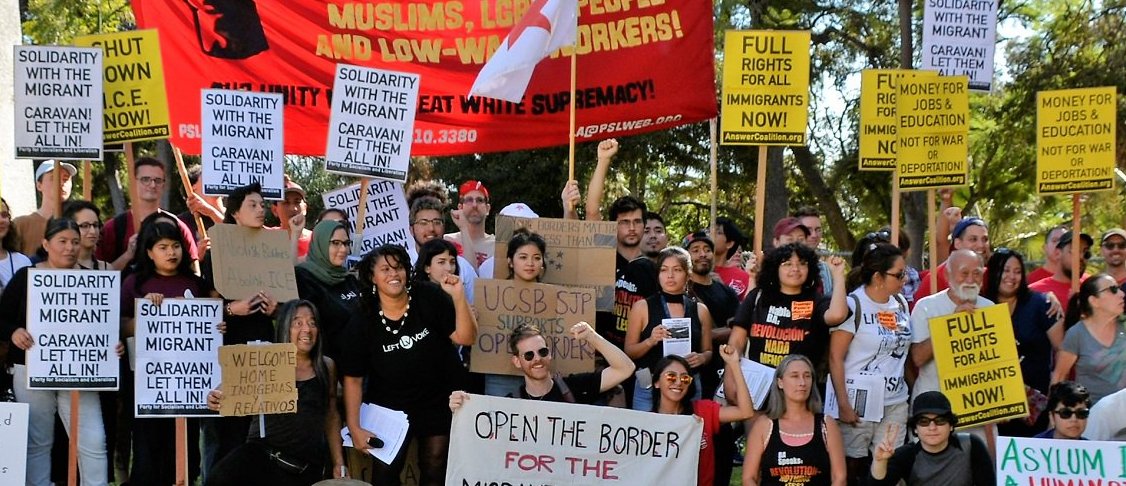
Migrant solidarity action in Los Angeles, November 2018. (ANSWER)
• Refuse
Illegal Orders to Build and Man Concentration Camps
- Courage to Resist -
• No Troops on the Border!
- Veterans for Peace -
• U.S. Military Plans Large Scale
Mass Training on Use of Force
- Weekly Reveal, Center for Investigative Reporting -
• Trump's Military Deployment to
U.S.-Mexico Border Is Illegal
- Marjorie Cohn -
• Rights Groups Seek to Block Trump's
Asylum Order
• Illegal Pushbacks, Arbitrary
Detention and
Ill-Treatment of Asylum-Seekers
- Amnesty International -
• Constitutional Law Scholars Say
Trump Cannot Eliminate
Birthright Citizenship Through Executive
Action
• An Executive Order Cannot Repeal
Birthright Citizenship, Period
- Stephen Yale-Loehr -
• Next Time ICE Rounds Up Workers,
Remember that
We Did Not Do the Same with Nazi-Era War
Criminals
- Jared McBride -
• A Century of U.S. Intervention
Created Immigration Crisis
- Mark Tseng-Putterman -
United States -- People's Resistance
Defends the
Rights of All and
Opposes Politics of Division and Arbitrary Police Powers
Refuse Illegal Orders to Build and
Man Concentration
Camps
- Courage to Resist -
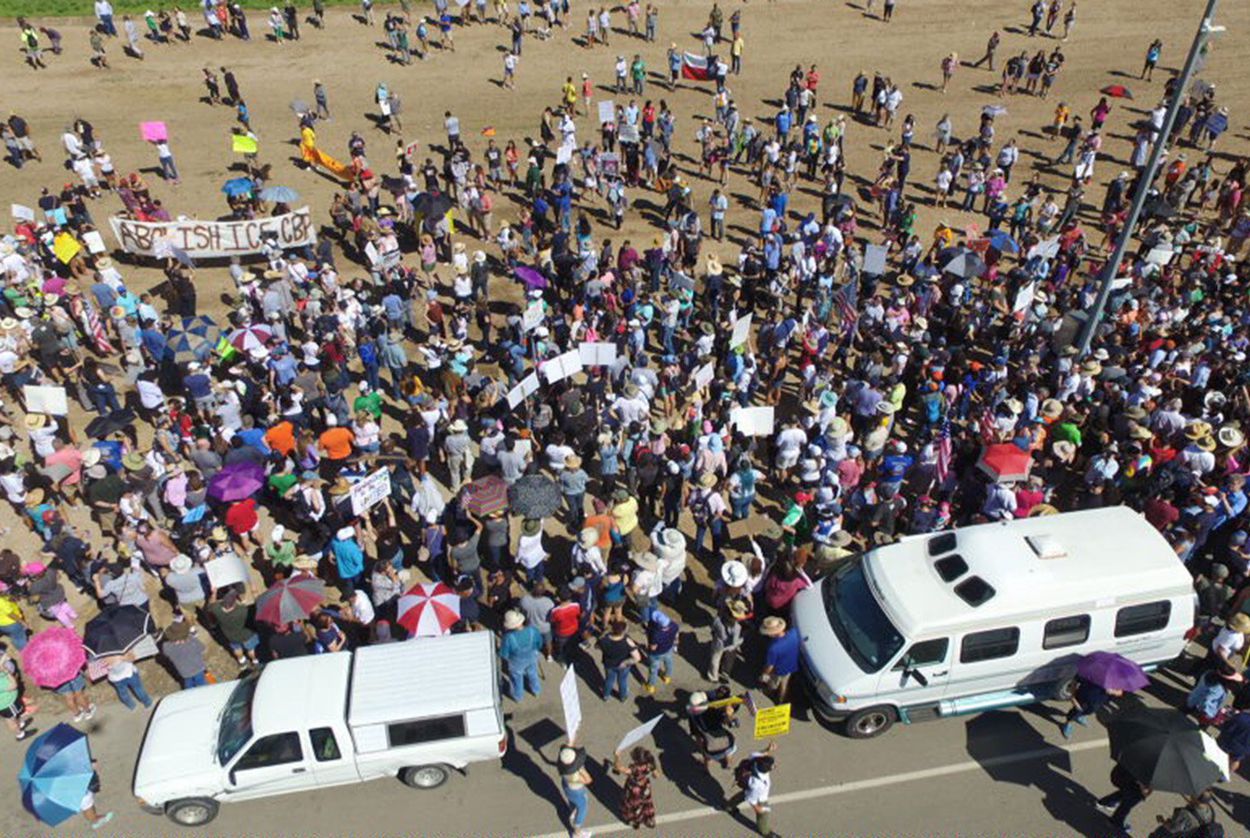
Protest outside the U.S. military's mass detention centre in Tornillo,
Texas in May 2018.
This summer, what might have been the defining low
point
of previous U.S. administrations, was simply the outrage of the
moment: A plan to have the military host massive concentration
camps of upward of 200,000 immigrant detainees across the United
States.
These camps do not appear to be going up as quickly nor
on
such a massive scale as first announced (quite possibly due to
the resistance on many levels), but they do appear to be moving
forward. On the Texas border at Tornillo Port of Entry, a tent
city that first detained a couple hundred children a few months
ago will hold nearly 4,000 kids by the end of the year.
Few people actually join the military to travel to
distant
lands to kill people. Fewer still join to help run concentration
camps. Under both U.S. and international law, military personnel
have a moral and legal obligation to refuse to comply with any
order that involves collaboration with these camps, but
unfortunately few are aware of this fact.
That is why we need your help. Together, we are going
to
launch a strategically targeted communications project to reach
service members across the country with this message:
- These camps are illegal and immoral.
- You have a
responsibility to refuse and expose these orders.
- Direct
military resistance is powerful.
Our initial goal is to raise $20,000 to spend
approximately
one penny per member of the U.S. military with this challenge. Of
course, we believe that service members deserve two cents worth
of encouragement if we can raise $40,000!
Just the idea of these massive military-hosted
immigrant
detention camps brings back memories of the forced relocation and
incarceration of 120,000 Japanese Americans during World War II.
Many of us thought something like that could never happen again,
and yet, here we are. Along with everything else you can do to
resist this affront to humanity, please support our challenge to
military personnel to refuse these illegal orders.
Potential Pentagon Plans for Concentration Camps
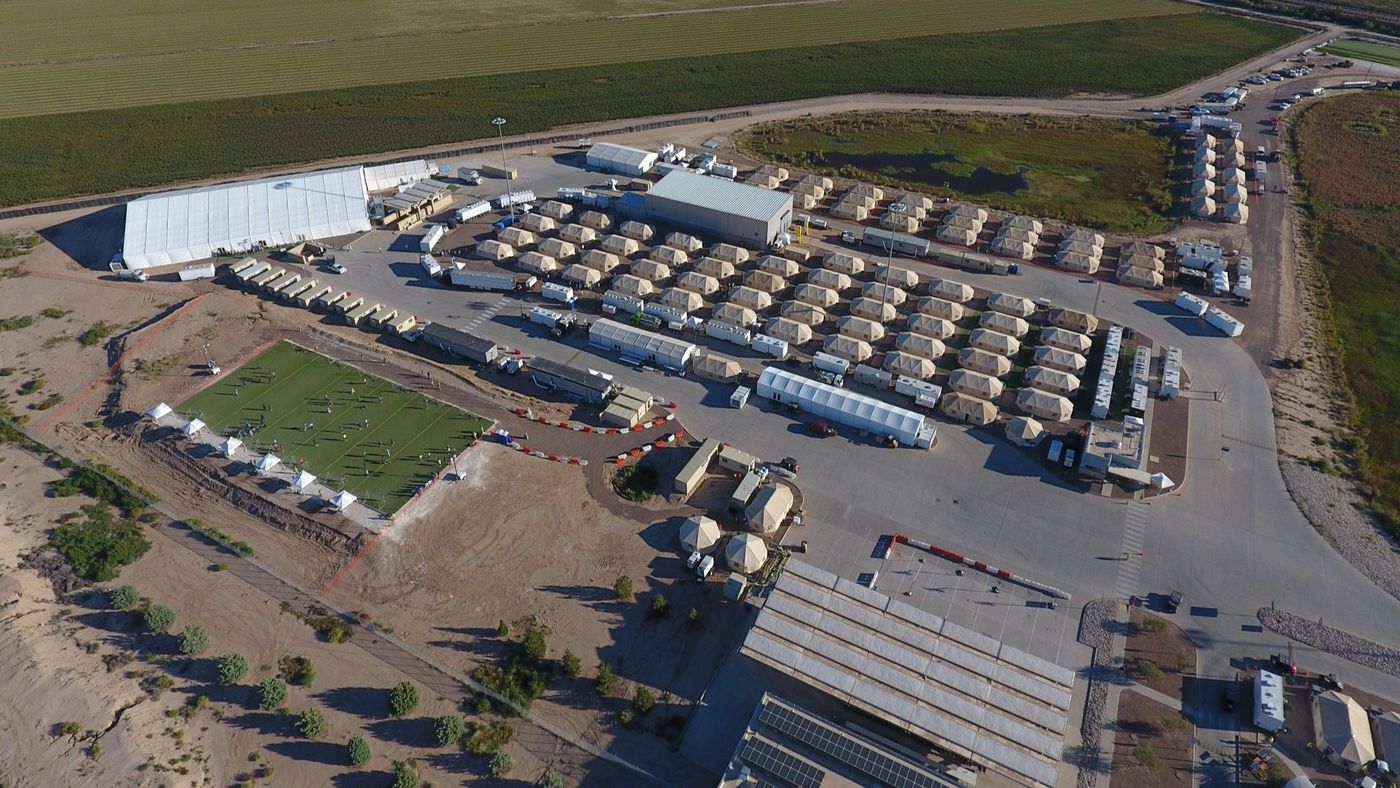
Aerial view of the Tornillo mass detention camp.
Actual concentration camps are in the process of
development
at military bases across the Southern United States. [The numbers
planned, close to 200,000, are far beyond the numbers of refugees
and immigrants entering the country. It is an indication that the
camps are designed for all deemed a "threat to national security"
by the government -- TML Ed. Note] Potential locations have been
identified by military or Pentagon personnel as:
- Tornillo Port of Entry, Texas -- capacity 4,000
teenagers (Already in use and being
expanded to 4,000 capacity by the end of the year)
- Goodfellow Air Force Base, Texas -- capacity 45,000
- Fort Bliss, Texas
- Dyess Air Force Base, Texas
- Little Rock Air Force Base, Arkansas -- capacity 20,000
- Camp Pendleton Marine Corps Air Station, California -- capacity 47,000
- Navy Outlying Field Wolf and Silverhill, Alabama -- capacity 25,000
- Yuma Marine Corps Air Station, Arizona
- Concord Naval Weapons Station, California -- capacity 47,000
(Opposition by local
community and officials brought a cancellation for this camp, at least
for now)
This is not the first time in U.S. history that
facilities
are being constructed and used to imprison large numbers of a
persecuted minority in a relatively small area with inadequate
facilities (the definition of a concentration camp). Previous
examples of this are now infamous, such as the internment camps
of Japanese Americans.
Military officials, in response to pressured deadlines
from
the White House, have stated that these camps can begin to be
operational by mid-August. Estimates are that capacity for
another 10,000 people can be added each month. The White House's
stated timeline of 45 days out from June 27 has local base
commanders scrambling and caught unaware. [The camps are being
built at a slower rate but expansion plans remain -- TML Ed.
Note]
In addition to providing the land, military personnel
will
construct the camps while private agencies will manage the
operations. While this simplified explanation of operations seeks
to minimize the military's role, it omits the endless capacities
in which the armed forces will surely be facilitating the
functioning of these camps such as with water, electricity,
sewage, trash, and all of the other services that go with
sustaining tens of thousands of immigrant detainees.

Scene from a mass detention centre in Rio Grande City, Texas, where
children
separated from their parents are detained, June 17, 2018.
Additional operational problems include the difficulty
of
housing persons in restricted access bases who legally need
access to immigration and civil-liberties lawyers, secure areas
to discuss their cases, as well as access for advocates,
relatives, news media and political activists. Another issue is
the lack of state licensing requirements, such as health and
building codes, which military locations enable the government to
avoid.
The Pentagon confirmed that it was indeed working with
the
Department of Homeland Security (DHS) to construct these camps, [but it
remains unclear if there is a] Memorandum of
Understanding with either DHS or Health and Human Services (HHS).
A memorandum would clearly delineate the roles and
responsibilities of all parties. To move forward with
construction plans without one, nor any clear legal guidance,
certainly leads military personnel into dangerous waters for
themselves.
The military is strictly prohibited from domestic
policing
yet military personnel are being drafted into doing just that
with this rising domestic enforcement of immigration policy. Just
because Trump/Sessions Co. declares a war on immigrants, does not
make it an actual war. Being quite clearly an illegal order, the
question is who will refuse to aid and abet?
The Trump administration's reckless leadership is
currently
putting military personnel in danger of running afoul of the law.
While military personnel at all levels have a responsibility to
refuse to participate in facilitating these camps, commanders in
particular are at a particularly high risk in complying with
these orders due to the precedent of the Nuremberg prosecution of
those who aided and abetted Nazi leadership.
Already the construction of one camp has been abandoned
due
to people's refusal to look the other way. The proposed use of
the Concord Naval Weapons Station experienced significant
resistance and outcry from the community and local officials who
opposed the plan once it was exposed in July via a leaked Navy
memo. DHS soon thereafter announced they would no longer build a
concentration camp at this location. To follow that up, the Contra
Costa Sheriff's Department announced it is cancelling its contract
with ICE which facilitated the local county jails holding
ICE-detained persons for a lucrative fee. These human rights
victories have been happening in other communities as well,
including Sacramento County. [...]
There are discussions and calls right now for counties
to
cease partnering with ICE, for communities surrounding military
bases to refuse to work on the bases which will hold tens of
thousands of people for the "crime" of seeking refuge.
Courage to Resist believes that all military personnel
have a
moral and legal obligation to refuse to comply with any order
that involves collaboration with these immigrant concentration
camps.

No Troops on the Border!
- Veterans for Peace -
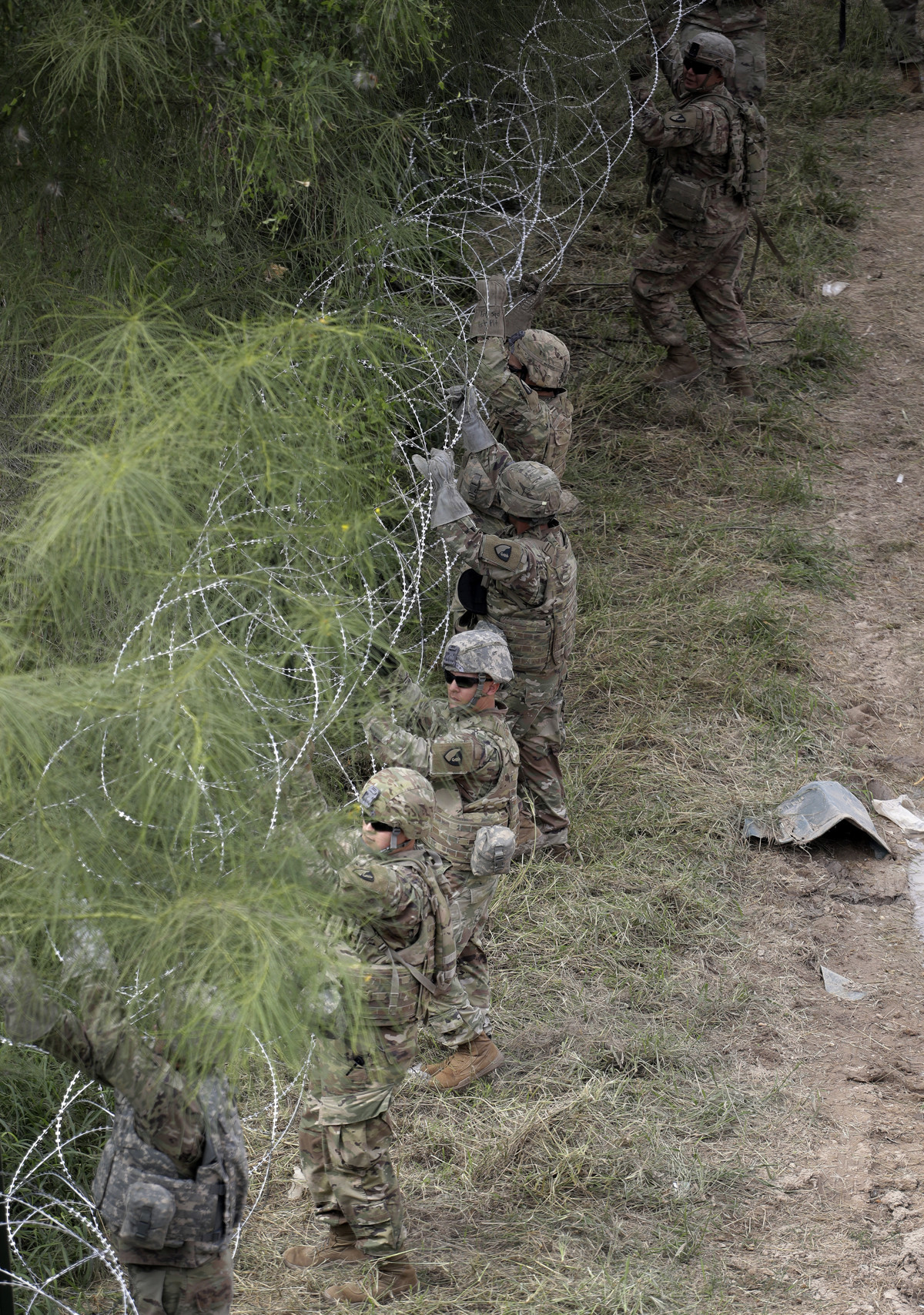 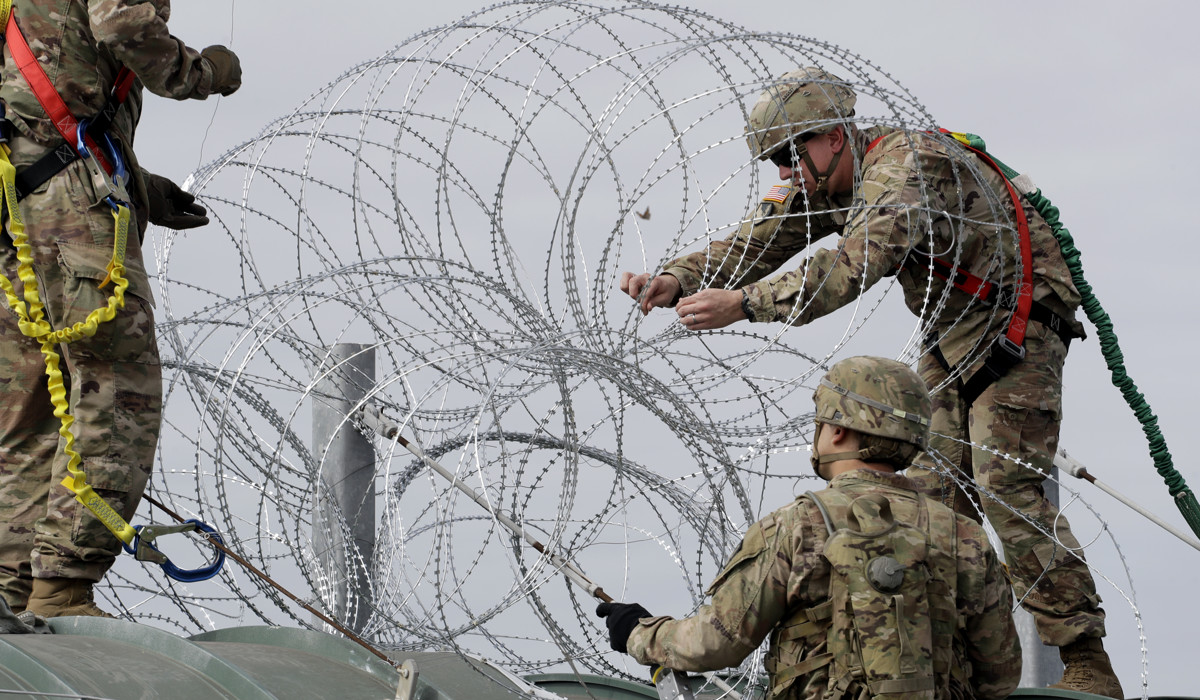
U.S. troops stretch razor wire across the border crossing between
McAllen, Texas
and Hidalgo, Mexico, November 12, 2018.
Veterans for Peace strongly condemns the recent
announcement that up to 15,000 active duty military personnel may
be sent to the U.S. southern border. These troops will join the
additional National Guard units that were sent last year,
increasing the militarization of our borders at an alarming rate.
Our immigration laws and enforcement tactics have long been at a
crisis point and we are now witnessing an even more draconian
surge in the use of force to prop up failed policies.
Veterans For Peace calls on all our members and all
veterans
who see the inhumanity and injustice of the current policies to
call their Congressional Representative and Senators to demand
the military be pulled back from the border and that the members
of the approaching caravan be treated with dignity and processed
according to international humanitarian standards as refugees. We
call on all service members participating in the border
deployment to follow the long American tradition of listening to
their conscience and remember that they have no obligation to
follow illegal orders. (For questions on military rights, contact
the GI Rights Hotline (1-877-447-4487) or Courage to Resist.)
The U.S. government, instead of welcoming the
approaching
refugees, the majority of whom will seek asylum under completely
legal processes, is treating individuals and families fleeing to
the U.S. as if they are "terrorists" (even when
"counterterrorism" officials within the administration are
stating that no such people exist within the caravan). The
majority of these refugees are fleeing from violence in Honduras
and a political situation U.S. actions have made worse.
The U.S. government's claims that active duty troops
are
providing only innocuous support services are misleading. This is
the introduction of U.S. military force as a deterrent to those
who are pursuing their rights as asylum seekers fleeing from
extreme poverty and violence in their homelands, much of it due
to U.S. policies. The U.S. is required under international
humanitarian standards to welcome those seeking refuge.
Veterans For Peace recognizes that these orders did not
happen in a vacuum but represent a long history over several
administrations of racist and violent policies that has
perpetuated U.S. wars across the world and horrific domestic
policies that created Immigration and Customs Enforcement (ICE),
massive immigration detention centres and a wall that already
splits towns and separates friends and families. However, the
Trump administration has escalated, at an alarming pace, the
implementation of new dangerous measures. [...]
Veterans For Peace is not only concerned about the
safety of
individuals and families fleeing violence and the increased
militarization of the border but we are extremely concerned about
the continued disregard of federal law. Federal law, namely the Posse
Comitatus
Act, prohibits the deployment of
active-duty troops on domestic soil and the U.S. Government continues
to
ignore laws in favour of increasing militarization of U.S.
domestic policy.
As military veterans from WWII to the current era of
conflicts, who have trained for, and in many cases, fought in
U.S. wars, we know that current U.S. policies have not only
failed to bring peace but are morally bankrupt and we do not
believe that more military at the border is rooted in justice or
compassion.
It is more important than ever that veterans stand up,
speak
out and organize to disrupt the dangerous escalation of racist
and unjust policies, both at home and abroad. We, as veterans,
know that peace is possible, but only if resources are directed
towards caring for one another, not perpetuating militarization
across the globe. [Veterans for Peace
members are currently
spreading out along the border to urge troops to refuse the
orders and to assist those that do -- TML Ed Note]

U.S. Military Plans Large Scale
Mass Training on Use of
Force
- Weekly Reveal, Center for Investigative
Reporting -
 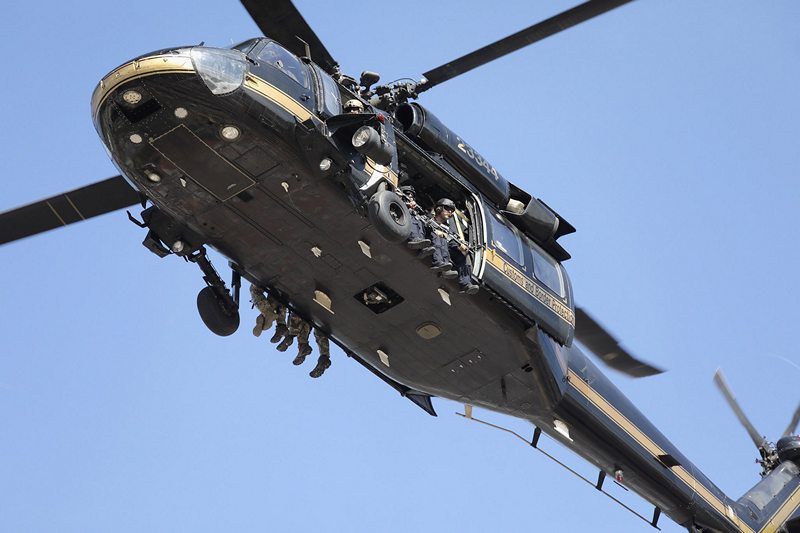
Heavily armed and militarized U.S. Customs and Border Protection forces
carry out a
training exercise at the border with Mexico, November 5, 2018.
With President Donald Trump deploying 7,000 troops this
month [November] to help the U.S. Border Patrol confront a migrant
caravan
from Central America, one important question stands out: How well
are government forces trained to deal with a large group of
civilians?
The migrants are unarmed, though several of them
reportedly
threw rocks at Mexican officers as they crossed that country's
border a few weeks ago. Trump recently said any rocks thrown at
troops would be considered a rifle after a reporter asked if the
military would fire at the migrants.
"We're not going to put up with that. They want to
throw
rocks at our military, our military fights back," Trump said. He
later backtracked on his comments, saying that migrants would be
arrested instead.
Reveal asked Customs and Border Protection about the
kind of
training officers would complete in anticipation of the migrants'
arrival. The agency provided a statement saying officers will be
"participating in operational readiness exercises." It did not
respond to a reporter's follow-up questions.
Reveal posed the same questions to the Department of
Defense.
General Terrence John O'Shaughnessy, the commander leading the
border operation, told reporters last week that troops would
receive use-of-force training.
"We are, in fact, as an example, setting up training
programs
that'll be all the way from a large-scale mass training that will
then go down to unit training," he said.
Pentagon spokesman Jamie Davis told Reveal that
training will
depend on each troop's assignment. He said he did not immediately
have details about what the training would entail.
In general, soldiers, like police, are instructed to
use
force to defend themselves from "imminent threat of physical
injury or death," as well as to overcome resistance during an
arrest, prevent destruction of military property, or to control
or restrain animals, according to a Department of Defense
directive obtained by the Federation of American Scientists. They
are also trained in "scaled use of force," which includes a
variety of non-lethal tactics such as voice commands, pepper
spray and batons.
Besides the thousands of troops, the military will be
providing helicopters "to support the movement of Customs and Border
Protection tactical
personnel," as well as medical teams, temporary housing, light
towers and fencing materials like barbed wire, according to the
Department of Defense.
Then there are the so-called militia groups who say
they are
headed to the border to confront the caravan. The militias are
governed by another set of rules: Forty-one states have laws
restricting private military activity, including Arizona, Texas
and California.

Trump's Military Deployment to
U.S.-Mexico Border Is
Illegal
- Marjorie Cohn -
Donald Trump's decision to send thousands of troops to
the
U.S.-Mexican border to intercept migrants who intend to apply for
asylum is not just a bald-faced political stunt -- it is also
illegal.
Passed in 1878 to end the use of federal troops in
overseeing
elections in the post-Civil War South, the Posse Comitatus
Act forbids the use of the military to enforce domestic U.S.
laws, including immigration laws. For this reason, Trump's
decision to deploy the military to the border to enforce U.S.
immigration law against thousands of desperate migrants from
Central America -- who have undertaken the perilous journey over
1,000 miles through Mexico to the U.S. border in order to apply
for asylum -- is an unlawful order. [...]
The illegality of Trump's order to the military opens
the
door to the possibility that service members will resist it:
Under the Uniform Code of Military Justice, Nuremberg Principles
and Army Field Manuals, service members have a duty to obey
lawful orders and a duty to disobey unlawful orders. [...]
On October 29, describing the impending arrival of
migrants
seeking asylum as an "invasion," Trump tweeted, "This is an
invasion of our Country and our Military is waiting for you!"
Military Is Legally Forbidden from Enforcing
Immigration Law
The Posse Comitatus Act forbids
the
wilful use of "any part of the Army or the Air Force as a posse
comitatus or otherwise to execute the laws." It has been applied
as well to the Navy and Marine Corps. The only exception to the Posse
Comitatus
Act's prohibition is "in cases and
under
circumstances expressly authorized by the Constitution or Act of
Congress."
Defense Department officials told the New York Times
that troops deployed to the border would help construct tents and
fencing and some would "potentially" operate drones on the
border. Whether the drones are armed or used for surveillance,
they would be assisting in the enforcement of the immigration
laws.
Moreover, the Los Angeles Times reported,
"Black Hawk
helicopters equipped with night sensors will be available to
ferry Border Patrol personnel 'exactly where they need to be' to 'spot
groups' and 'to fast-rope down' to intercept migrants
trying to cross the border. Military aircraft will conduct
surveillance." Troops who carry out these functions would also be
participating in the enforcement of the immigration laws. Only in
the event of an invasion or insurrection on U.S. soil does the
president have the power to order the use of the military within
the United States. There is no invasion or insurrection
occasioned by the migrant caravan. In an interview with the New
York Times, Admiral James G. Stavridis, former
commander
of the U.S. military's Southern Command, called out Trump's
"fictitious caravan invasion." [...]
Duty to Disobey Unlawful Orders
The Uniform Code of Military Justice requires
that all
military personnel obey lawful orders. Article 92 of the Uniform
Code of Military Justice says, "A general order or regulation is
lawful unless it is contrary to the Constitution, the laws of the
United States...." Both the Nuremberg Principles and the Army Field
Manuals create a duty to disobey unlawful orders.
"Sending troops to the U.S. border with Mexico is as
immoral
and illegal as sending them to invade and occupy foreign lands,"
said Gerry Condon, president of Veterans For Peace. "Donald Trump
is carrying out a racist war against asylum seekers who are
fleeing extreme violence, which in turn is caused by decades of
U.S. support for repressive regimes in Central America."
Members of Veterans For Peace are fanning out along the
U.S./Mexico border from California to Texas in order to reach out
to the troops that Trump has ordered to the border. Condon added,
"Soldiers who follow their conscience and refuse to follow
illegal orders will have our support. We can also put GIs in
contact with legal resources to help them get honourably
discharged from the military."
Trump's Illegal Attack on the Right to Apply for
Asylum
Under the 1951 Refugee Convention, any person who
arrives in
the United States has the right to apply for asylum. Applicants
must show they are unable or unwilling to return to their country
of origin due to a well-founded fear of persecution on account of
race, religion, nationality, membership in a particular social
group, or political opinion. Yet Trump's new proclamation would
deny migrants the right to apply for asylum unless they entered
the United States at a designated port of entry, which violates
the 1951 Refugee Convention.
On November 9, the American Civil Liberties Union,
Southern Poverty Law Center,
and
Center for Constitutional Rights filed a lawsuit in the United
States District Court for the Northern District of California,
seeking an injunction to block Trump's new restrictions on
asylum. The complaint states that Trump's proclamation is "in
direct violation of Congress's clear command that manner of entry
cannot constitute a categorical asylum bar." [...]
Nearly 2,500 hopeful migrants have already arrived in
Tijuana
and thousands more are en route. Several organizations, including
the National Lawyers Guild, have sent legal backup to the border.
Members of Veterans For Peace are also at the border, offering
support to troops who refuse unlawful orders to enforce the
immigration laws.

Rights Groups Seek to Block Trump's Asylum Order
Update: On November 20, a federal judge issued a
temporary restraining order, which is supposed to block Trump from
implementing the asylum ban. However, given that such court orders have
been issued on matters like detention and family separation (see
article below) and the government continues to implement its attacks,
it is not likely that the executive will submit to this order. Being
informed about facts on the ground and persisting in defending rights
is needed.
***
Civil rights groups in the U.S. have filed a federal
lawsuit challenging the legality of U.S. President Donald Trump's
newly announced restrictions that would effectively bar migrants
who did not enter the country at a port of entry from qualifying
for asylum. The Trump order is directly against U.S. and
international law concerning refugees, which requires the U.S. to
accept refugees and hear their asylum cases regardless of where
they entered the country.
 The lawsuit was filed in San
Francisco federal court by
the
American Civil Liberties Union, Southern Poverty Law Center and
Center for Constitutional Rights. It seeks an injunction to
prevent the administration from implementing the asylum policy.
It charges the administration with violating the Immigration
and Nationality Act as well as the Administrative
Procedure Act. The lawsuit was filed in San
Francisco federal court by
the
American Civil Liberties Union, Southern Poverty Law Center and
Center for Constitutional Rights. It seeks an injunction to
prevent the administration from implementing the asylum policy.
It charges the administration with violating the Immigration
and Nationality Act as well as the Administrative
Procedure Act.
Trump signed a proclamation November 9 that will
suspend the
granting of asylum to children, women and men who do not cross
the U.S./Mexico border at port of entry locations for up to 90
days. The order, which goes into effect on November 10, means
that migrants will have to present themselves at U.S. ports of
entry to qualify for asylum. Existing law directly states that
those entering anywhere along the border asking for asylum must
be given protection. It is well-known that the government has
been illegally forcing people to return even when they enter at
ports of entry and has also illegally detained and deported many
with legitimate claims.
The civil rights groups involved emphasized that U.S.
immigration law clearly allows anyone present in the country to
seek asylum, regardless of how they crossed the border.
"President Trump's new asylum ban is illegal. Neither the
president nor his cabinet secretaries can override the clear
commands of U.S. law, but that's exactly what they're trying to
do. This action undermines the rule of law and is a great moral
failure because it tries to take away protections from
individuals facing persecution," Omar Jadwat of the American
Civil Liberties Union said in a statement.
"The asylum ban, coupled with Customs and Border
Protection's widespread practice and policy of turning back individuals
attempting to seek asylum at ports of entry, would effectively
deny protection to thousands of vulnerable individuals. The
government's blatant disregard for the rights of asylum seekers
cannot stand," said Melissa Crow, Southern Poverty Law Center
senior supervising attorney.
Baher Azmy, legal director of the Center for
Constitutional
Rights, added, "Ever since the horrors of World War II, the
world's nations have committed to giving asylum seekers the
opportunity to seek safe haven. The Trump administration cannot
defy this most elementary humanitarian principle, in violation of
U.S. and international law, with a flip of a presidential
pen.

Illegal Pushbacks, Arbitrary Detention and
Ill-Treatment of
Asylum-Seekers
- Amnesty International -
The U.S. government has deliberately adopted
immigration
policies and practices that caused catastrophic harm to thousands
of people seeking safety in the United States, including the
separation of over 6,000 family units in a four-month period, more
than previously disclosed by authorities, Amnesty International
said in a new report released [October 11].
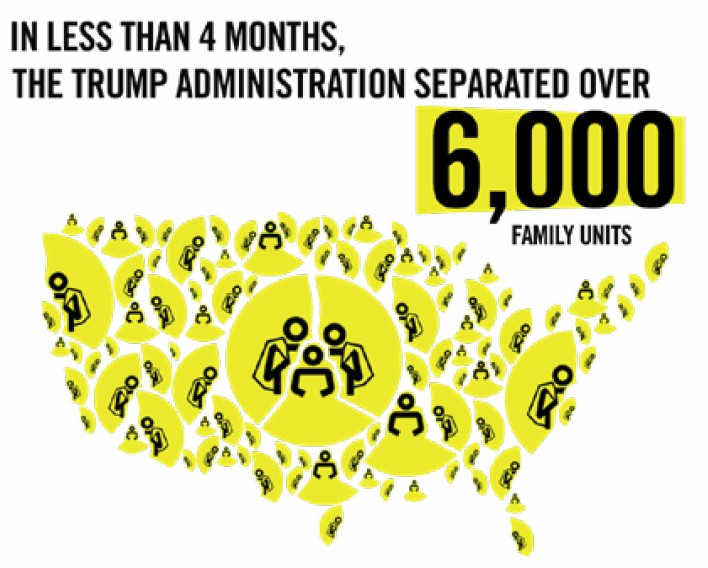 The report, "'You Don't Have Any Rights Here:' Illegal
Pushbacks, Arbitrary Detention and Ill-treatment of
Asylum-seekers in the United States" reveals the brutal toll of
the Trump administration's efforts to undermine and dismantle the
U.S. asylum system in gross violation of U.S. and international
law. The cruel policies and practices documented include: mass
illegal pushbacks of asylum-seekers at the U.S.-Mexico border;
thousands of illegal family separations; and increasingly
arbitrary and indefinite detentions of asylum-seekers, frequently
without parole. The report, "'You Don't Have Any Rights Here:' Illegal
Pushbacks, Arbitrary Detention and Ill-treatment of
Asylum-seekers in the United States" reveals the brutal toll of
the Trump administration's efforts to undermine and dismantle the
U.S. asylum system in gross violation of U.S. and international
law. The cruel policies and practices documented include: mass
illegal pushbacks of asylum-seekers at the U.S.-Mexico border;
thousands of illegal family separations; and increasingly
arbitrary and indefinite detentions of asylum-seekers, frequently
without parole.
"The Trump administration is waging a deliberate
campaign of
widespread human rights violations in order to punish and deter
people seeking safety at the U.S.-Mexico border," said Erika
Guevara-Rosas, Americas Director at Amnesty International. She
added, "The intensity, scale and scope of the abuses against
people seeking asylum are truly sickening. Congress and U.S. law
enforcement agencies must conduct prompt, thorough and impartial
investigations to hold the government accountable and ensure this
never happens again."
Approximately 8,000 Family Units Separated in 2017 and
2018
Last month, Customs and Border Protection (CBP)
disclosed to
Amnesty International that it forcibly separated over 6,000
family units (a term that U.S. authorities have used inconsistently
to refer to whole families or individual family members) from April 19
to August 15, 2018 alone -- more than U.S. authorities had
previously admitted. CBP confirmed that this figure still
excluded an undisclosed number of families whose separations were
not properly recorded, such as grandparents or other
non-immediate family members, whose relationships authorities
categorize as "fraudulent" and do not count in their statistics.
In total, the Trump administration has now admitted to separating
approximately 8,000 family units since 2017.
"These shocking new numbers suggest that U.S.
authorities
have either misinformed the public about how many families they
had forcibly separated, or they continued this unlawful practice
unabated, despite their own claims and court orders to halt
family separations," said Guevara-Rosas. "Congress must act
immediately to investigate and establish a comprehensive record
of family separations by U.S. government authorities, and pass
legislation prohibiting the separation and indefinite detention
of children and families," she demanded.
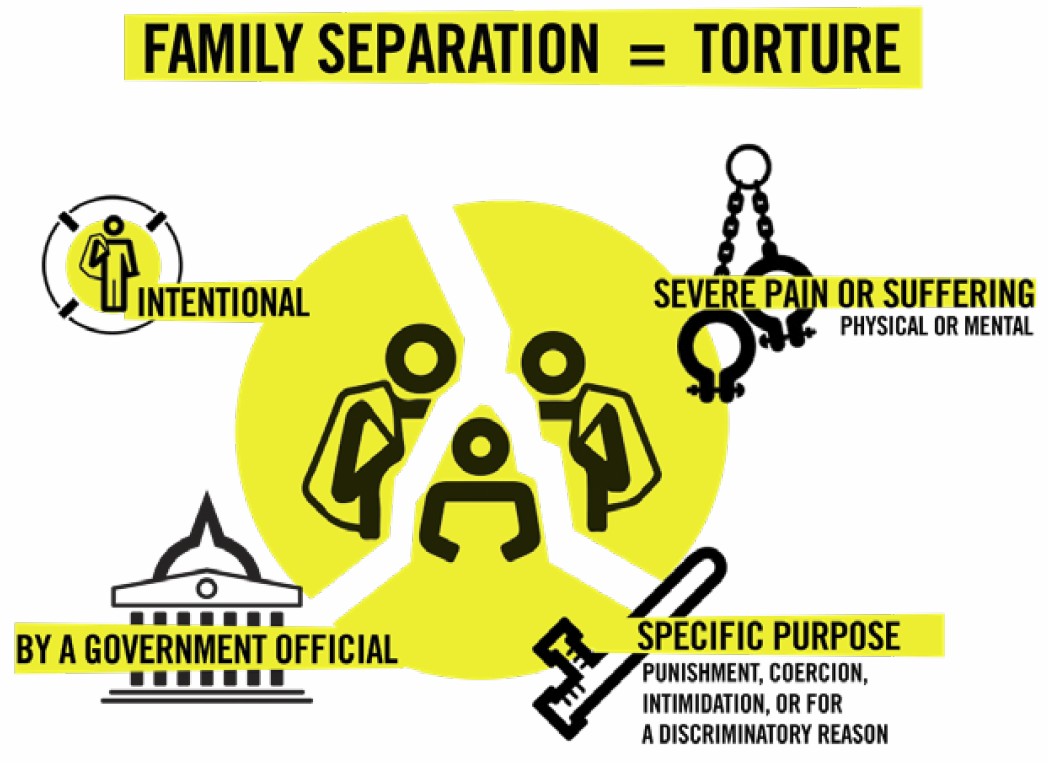 The extreme suffering that U.S. authorities
purposefully
inflicted by separating families constituted ill-treatment and in
some cases torture. Amnesty International interviewed 15 parents
and guardians separated from their children by U.S. border and
immigration authorities, including 13 who presented themselves at
official border crossings. Those family separations resulted in
extreme anguish, and in some instances long-term trauma, for
adults and children alike. The extreme suffering that U.S. authorities
purposefully
inflicted by separating families constituted ill-treatment and in
some cases torture. Amnesty International interviewed 15 parents
and guardians separated from their children by U.S. border and
immigration authorities, including 13 who presented themselves at
official border crossings. Those family separations resulted in
extreme anguish, and in some instances long-term trauma, for
adults and children alike.
In an immigration detention facility in Texas, a
39-year-old
Brazilian mother named Valquiria told Amnesty International that
CBP agents separated her from her seven-year-old son, without
providing any reason, the day after they requested asylum at an
official port-of-entry in March 2018.
"They told me: 'You don't have any rights here, and you
don't
have any rights to stay with your son,'" Valquiria said. "I died
at that moment. It would have been better if I had dropped dead ...
Not knowing where my son was, what he was doing. It was the worst
feeling a mother could have. How can a mother not have the right
to be with her son?"
Illegal Pushbacks and Arbitrary Detention
In 2017 and 2018, CBP implemented a de facto policy of
turning away thousands of people seeking asylum at official
ports-of-entry along the entire U.S.-Mexico border.
"Every human being in the world has the right to seek
asylum
from persecution or serious harm, and request protection in
another country," said Erika Guevara-Rosas. "U.S. border
authorities are flagrantly violating U.S. asylum law and
international refugee law by forcing people back to Mexico
without registering and determining their asylum claim. People
pushed back to Mexico may face direct abuses there or deportation
and the risk of serious human rights violations in their
countries of origin," she added.
Since 2017, U.S. authorities have also imposed a policy
of
mandatory and indefinite detention of asylum-seekers, frequently
without parole, for the duration of their asylum claims. This
constitutes arbitrary detention, in violation of U.S. and
international law.
Amnesty International interviewed asylum-seekers being
detained indefinitely after requesting protection, including
separated family members, older people, and persons with acute
health conditions and medical needs.
The organization also documented the cases of 15
transgender
and gay asylum-seekers who were detained for periods ranging from
several months to almost three years without parole, including
two people who were denied parole despite having suffered sexual
assaults while in detention. In several cases, their experiences
of indefinite detention constituted ill-treatment.
Congress must act now to end the detention of children
and
families once and for all -- and fund alternative options, such
as the Family Case Management Program, which have been proven to
be 99 per cent effective in helping asylum-seeking families
understand and comply with their immigration hearing
requirements."

Constitutional Law Scholars Say Trump
Cannot Eliminate
Birthright Citizenship
Through Executive Action
Constitutional law
scholars in the U.S. recently released the
following statement arguing that there is no serious
scholarly debate about whether a president can, through executive
action, eliminate birthright citizenship and contradict the
Supreme Court's long-standing and consistent interpretation of
the Citizenship Clause of the 14th Amendment.
***
U.S. President Donald Trump is reportedly considering
an
executive order to essentially rewrite the Citizenship Clause of
the 14th Amendment to eliminate birthright citizenship. In an
interview [published October 30] to be aired [on HBO] later this week,
he explains that
people are now telling him that he can do this "just with an
executive order." As constitutional scholars who have studied the
14th Amendment, we write to say in no uncertain terms that he is
wrong.
The Citizenship Clause -- enshrined as Section 1 of the
14th
Amendment to the U.S. Constitution in 1868 -- states simply that
"All persons born or naturalized in the United States, and
subject to the jurisdiction thereof, are citizens of the United
States and the State wherein they reside." The 14th Amendment,
adopted in the immediate aftermath of a Civil War that very
nearly ripped this country in two, established the foundational
principle that all persons are entitled to due process and equal
protection under the law. The Citizenship Clause contained
therein was meant as a direct rebuke to the infamous decision in Dred
Scott
v.
Sandford, 60 U.S. (19 How.) 393
(1857), in
which the Supreme Court held that people of African descent born
on our soil whose ancestors were slaves could not be citizens,
even if they were free.
|
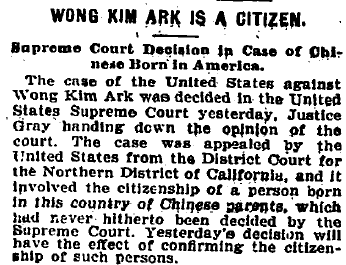
Washington Post
article from March 29, 1898.
|
The U.S. Supreme Court 120 years ago in United
States v.
Wong Kim Ark, 169 U.S. 649 (1898), settled the very issue
raised by the president. In that case, the Court held that with
certain very limited exceptions, all children born in the United
States are natural-born citizens regardless of the citizenship
status of their parents. Many decades later in the case of Plyler
v. Doe, 457 U.S. 202 (1982), in which the Court
upheld the right of all children regardless of alienage to a free
public education, the Court analogized its holding on Equal
Protection Clause grounds to the settled law on the Citizenship
Clause as declared in Wong Kim Ark. Specifically, the
Court noted that just as undocumented immigrants are "subject to
the jurisdiction of the United States" for purposes of the
Citizenship Clause, they too are "within the jurisdiction" of a
state for purposes of the Equal Protection Clause. (Id. at 211
n.10.) There is today no serious scholarly debate about whether a
president can, through executive action, contradict the Supreme
Court's long-standing and consistent interpretation of the Citizenship
Clause of the 14th Amendment. Instead, as
conservative legal scholar James Ho, now a federal judge on the
U.S. Court of Appeals for the 5th Circuit nominated by President
Trump, wrote more than a decade ago, "a constitutional amendment
is the only way to restrict birthright citizenship." The
executive branch's own lawyers have long agreed.
It took a Civil War -- the bloodiest conflict in
American
history -- to resolve a dispute about what it means to be an
American -- a person -- in this country. The 14th Amendment,
including the Citizenship Clause, is the rightly cherished result
of that American tragedy.
(The statement was signed by Muneer I. Ahmad, Yale
Law
School; Walter E. Dellinger III, Duke University School of Law;
Lucas Guttentag, Stanford Law School and Yale Law School; Harold
Hongju Koh, Yale Law School; Stephen H. Legomsky, Washington
University School of Law; Gerard N. Magliocca, Indiana University
Robert H. McKinney School of Law; David A. Martin, University of
Virginia School of Law; Michael W. McConnell, Stanford Law
School; Hiroshi Motomura, University of California, Los Angeles
(UCLA) School of Law; Gerald L. Neuman, Harvard Law School;
Cristina Rodríguez, Yale Law School; Peter J. Spiro, Temple
University Law School; Geoffrey R. Stone, The University of
Chicago; Laurence H. Tribe, Harvard Law School; Stephen I.
Vladeck, The University of Texas at Austin Law School)

An Executive Order Cannot Repeal
Birthright
Citizenship,
Period
- Stephen Yale-Loehr -
President Trump's assertion ... that he is
considering signing an executive order to end "birthright
citizenship" to children born in the United States to
undocumented parents has created a firestorm of controversy.
Rightly so. The idea should be rejected for the following
reasons.
First, the law is clear. The 14th Amendment to the U.S.
Constitution states that "All persons born or naturalized in the
United States, and subject to the jurisdiction thereof, are
citizens of the United States and of the State wherein they
reside." Courts and legal scholars have consistently interpreted
that language to include children born in the United States.
The Supreme Court decided this issue 120 years ago, in
an
1898 case called Wong Kim Ark. The court ruled that a
child born in San Francisco to Chinese parents was a U.S.
citizen, even though the Chinese Exclusion Act barred his
parents from ever becoming citizens. "To hold that the 14th
Amendment of the Constitution excludes from citizenship the
children, born in the United States, of citizens or subjects of
other countries," the court said, "would be to deny citizenship
to thousands of persons of English, Scotch, Irish, German or
other European parentage who have always been considered and
treated as citizens of the United States."
The Supreme Court's decision in Wong Kim Ark
did not specifically discuss the citizenship status of children of
unauthorized immigrants. Nor could it have. The concept of
unauthorized immigration did not exist then. But in 1982, in Plyler
v. Doe, the court ruled that undocumented
children
were entitled to free public education. The court relied on
another part of the 14th Amendment, its equal protection clause,
and it interpreted language similar to that in the citizenship
clause.
The Plyler court noted in a footnote that "no
plausible distinction with respect to Fourteenth Amendment
'jurisdiction' can be drawn between resident aliens whose entry
into the United States was lawful, and resident aliens whose
entry was unlawful."
The Supreme Court's interpretation makes sense. As
fellow
law
professor and former USCIS Chief Counsel Stephen Legomsky has
noted, "Like anyone else, native-born Americans, whoever their
parents are, can be charged with crimes if they disobey U.S. law.
How would this be possible if the U.S. had no jurisdiction over
them?"
Second, even if the law were not clear, an executive
order is
the wrong procedural mechanism. A constitutional amendment can
only be undone by another constitutional amendment. Moreover, the
U.S. immigration statute also states that anyone born in the
United States is automatically an American citizen. Only Congress
can repeal a law, not the President. To do so by executive decree
would undermine our democracy.
Third, the practical problems in ending birthright
citizenship would be huge. Would the executive order apply
retroactively? If so, would that make some current U.S. citizens
deportable? What would happen in split families, for example,
where some children are born to undocumented parents, while
younger siblings are born here after their parents legalize? And
what would we do with children who become stateless? Ireland is
currently dealing with this problem because it removed birthright
citizenship. A 9-year-old boy there is facing statelessness and
deportation from his place of birth and only home.
The United States is not alone in granting automatic
citizenship to babies born in the country. NumbersUSA, a group
that favours reduced immigration, compiled a list of 33 countries
that grant citizenship to anyone born within their borders.
In sum, ending birthright citizenship is an overly
simple
solution for a complex problem: our broken immigration system.
Congress needs to tackle the problem; the president cannot do it
unilaterally.
It is unclear whether the President will actually sign
an
executive order ending birthright citizenship. His statement
could well be "vapourware," intended merely as a political ploy to
appeal to his base just before the midterm elections. But if
Trump really tries to do this, both the court of public opinion
and courts of law should immediately repudiate it and send it to
the dustbin of history.
Yale-Loehr is professor of immigration law practice
at
Cornell Law School. He is also co-author of "Immigration Law and
Procedure," a 21-volume immigration law treatise.

Next Time ICE Rounds Up Workers, Remember that We Did
Not Do
the Same with Nazi-Era War Criminals
- Jared McBride -
U.S. Immigration and Customs Enforcement (ICE) has been
making news with its brutal crackdowns on immigrants. Arrests of
men and women with no criminal record are up 142 per cent since January
2017. In December, the federal inspector general found widespread
civil rights abuses at ICE detention centres.
|

Click to enlarge.
|
We hear daily horror stories of longtime U.S. residents
torn
from their families: Edwin Marcial, father of four, who worked
for 15 years at the New York Bagel Co. in Brentwood, California
got detained. Stories like Marcial's abound: Jorge Garcia, a
39-year-old father of two from Detroit was deported to Mexico on
Martin Luther King Jr. Day. Green-card holder Dr. Lukasz Niec,
who has lived in the U.S. since he was 3, faces deportation for
misdemeanours committed 25 years ago, when he was a teenager.
ICE's deportation zeal stands in contrast to a
particularly
shameful chapter in its history. When it was known as the U.S.
Immigration and Naturalization Service (INS), from 1945 to 1979,
it repeatedly failed to investigate and remove European war
criminals from the U.S. and that included Holocaust
perpetrators.
The re-opening of our borders in the years following
World
War II allowed thousands of collaborators and accomplices of the
Nazi regime to make their way to the United States. A small
number of them were knowingly brought in by U.S. intelligence
services. Most came through the system undetected amid an influx
of nearly 400,000 war-displaced persons. At the time, officials
set a preposterously high bar for complicity in war crimes. That,
combined with an initial lack of knowledge about the Holocaust,
made it easy for applicants to cover up their backgrounds on
their immigration forms.
Once here, it was as easy to escape justice. Adrija
Artukovic, minister of the Interior and Justice in Croatia during
the war, sneaked into the U.S. under an assumed name in 1948 and
settled in Seal Beach, California. Known in Yugoslavia as the
Butcher of the Balkans, Artukovic was described by a U.S.
official as Croatia's Himmler. American authorities knew he was
here as early as 1949, but he was not arrested and returned to
Croatia for trial until the 1980s. His death sentence was never
carried out; he died in 1988.
For the first two decades after World War II, the INS
brought
very few "denaturalization" cases to court, a total of five for
the entire 1950s. Only one of these war criminals was
successfully denaturalized. The 1960s saw just two cases pursued,
despite INS being flooded with dozens if not hundreds of tips on
potential war criminals living among us. The cases it did manage
to bring to court in the 1950s and 1960s were so poorly
constructed that even a Romanian Iron Guard member and virulent
anti-Semite, Valerian Trifa, was not stripped of his citizenship.
As for deportations, the INS filed no more than 10 cases against
suspected war criminals from 1945 to 1973.
It is possible that skin color and country of origin
played a
role in the INS's lack of interest in investigating the war
records of newcomers from places like the Baltics and Ukraine.
They blended in, and records show that INS agents at every turn
had a hard time seeing these immigrants as dangerous. They
humanized them, and so did others, even after evidence emerged to
the contrary. A suspected Nazi unit commander was identified in a
Minnesota newspaper as a "pillar of the church" and a man who
"takes care of his yard and walks with his wife." A concentration
camp guard living in New York was referred to as a "feeble old
man" by neighbours.
The Kowalchuk brothers, Sergei and Mykola, of
Philadelphia,
served together in an auxiliary police force in the Ukrainian
town of Liuboml, where more than 4,000 Jews were killed. Sergei
was chief of police. In 1966, an INS investigator noted that
Mykola's Jewish boss told an interviewer he could not believe his
employee was complicit in wartime violence, as if such a comment
from such a source should be considered exculpatory. In a New
York Times article, a police officer and neighbour of
Kowalchuk's said, "They are good people from what I can see. They
get up early in the morning and work hard every day."
It took the efforts of two members of Congress,
Elizabeth
Holtzman and Joshua Eilberg, aided by Jewish organizations and
journalists, to call the INS to account for its failure to pursue
war criminals. Congressional hearings in the 1970s demonstrated
how often the agency had failed to act on tips and how badly it
botched investigations.
The hearings resulted in the establishment of an Office
of
Special Investigations in the Department of Justice specifically
to find and remove war criminals. Still, the INS was not
particularly cooperative: one document shows officers mocking the
new office.
ICE now houses the evidence of the INS' failures, and
it too
is not cooperative on the subject of war criminals. It has been
extremely reluctant to release its files through the Freedom
of Information Act, and when it does, it routinely applies
unwarranted redactions to their contents, demonstrating a higher
concern for the privacy of deceased accused war criminals than
for transparency about the agency's history. The next time you
hear about ICE agents hauling away a hard-working, law-abiding
immigrant, put the incident in the context of the same
institution's history of allowing Nazis, and their accomplices, a
safe haven in the United States. Like Mykola Kowalchuk, Edwin
Marcial is a "hard-working" member of his community -- but he is
not white and he did not participate in war crimes.
Jared McBride is a lecturer in the history
department at
UCLA.

A Century of U.S. Intervention
Created Immigration
Crisis
- Mark Tseng-Putterman -
A national spotlight now shines on the border between
the
United States and Mexico. [...] At the margins of the mainstream
discursive stalemate over immigration lies over a century of
historical U.S. intervention that politicians and pundits on both
sides of the aisle seem determined to silence. Since Theodore
Roosevelt in 1904 declared the U.S.'s right to exercise an
"international police power" in Latin America, the U.S. has cut
deep wounds throughout the region, leaving scars that will last
for generations to come. This history of intervention is
inextricable from the contemporary Central American crisis of
internal and international displacement and migration.
|

Click to enlarge.
|
The liberal rhetoric of inclusion and common humanity
is
insufficient: we must also acknowledge the role that a century of
U.S.-backed military coups, corporate plundering, and neo-liberal
sapping of resources has played in the poverty, instability, and
violence that now drives people from Guatemala, El Salvador, and
Honduras toward Mexico and the United States. For decades, U.S.
policies of military intervention and economic neo-liberalism have
undermined democracy and stability in the region.
In the past fifteen years alone, [the Dominican
Republic-Central America Free Trade Agreement (CAFTA-DR)] -- a free
trade
agreement between the U.S. and five Central American countries as
well as the Dominican Republic -- has restructured the region's
economy and guaranteed economic dependence on the United States
through massive trade imbalances and the influx of U.S.
agricultural and industrial goods that weaken domestic
industries. Yet there are few connections being drawn between the
weakening of Central American rural agricultural economies at the
hands of CAFTA-DR and the rise in migration from the region in
the years since. In general, the U.S. takes no responsibility for
the conditions that drive Central American migrants to the
border. U.S. empire thrives on amnesia. The Trump administration
cannot remember what it said last week, let alone the actions of
presidential administrations long gone that sowed the seeds of
today's immigration crisis. There can be no common-sense
immigration "debate" that conveniently ignores the history of
U.S. intervention in Central America. Insisting on American
values of inclusion and integration only bolsters the very myth
of American exceptionalism, a narrative that has erased this
nation's imperial pursuits for over a century.
As the British immigrant rights refrain goes, "We are
here
because you were there." The adage holds no less true here and
now. It is time to insist that accepting Central American
refugees is not just a matter of morality or U.S. benevolence.
Indeed, it might be better described as a matter of
reparations.
The following time-line compiles numerous sources to
lay out
an incomplete history of U.S. military and economic intervention
in El Salvador, Honduras, and Guatemala over the past
century.
El Salvador
1932: A
peasant rebellion, led by leader Farabundo
Martí,
challenges the authority of the government. Ten thousand to 40,000
rebels, many Indigenous, are systematically murdered by the
regime of military leader Maximiliano Hernández Martínez,
the
nation's acting president. The United States and Great Britain,
having bankrolled the nation's economy and owning the majority of
its export-oriented coffee plantations and railways, send naval
support to quell the rebellion.
1944:
Martínez is ousted by a bloodless popular
revolution
led by students. Within months, his party is reinstalled by a
reactionary coup led by his former chief of police, Osmín
Aguirre
y Salinas, whose regime is legitimized by immediate recognition
from the United States.
1960: A
military-civilian junta promises free
elections.
President Eisenhower withholds recognition, fearing a leftist
turn. The promise of democracy is broken when a right-wing
counter-coup seizes power months later. Dr. Fabio Castillo, a
former president of the national university, would tell Congress
that this coup was openly facilitated by the U.S. and that the
U.S. had opposed the holding of free elections.
1980-1992: A
civil war rages between the military-led
government and the Farabundo Martí National Liberation Front
(FMLN). The Reagan administration, under its Cold War containment
policy, offers significant military assistance to the
authoritarian government, essentially running the war by 1983.
The U.S. military trains key components of the Salvadoran forces,
including the Atlacatl Battalion, the "pride of the U.S. military
team in San Salvador." The Atlacatl Battalion would go on to
commit a civilian massacre in the village of El Mozote in 1981,
killing at least 733 and as many as 1,000 unarmed civilians,
including women and children. An estimated 80,000 are killed
during the war, with the UN estimating that 85 per cent of
civilian deaths were committed by the Salvadoran military and
death squads.
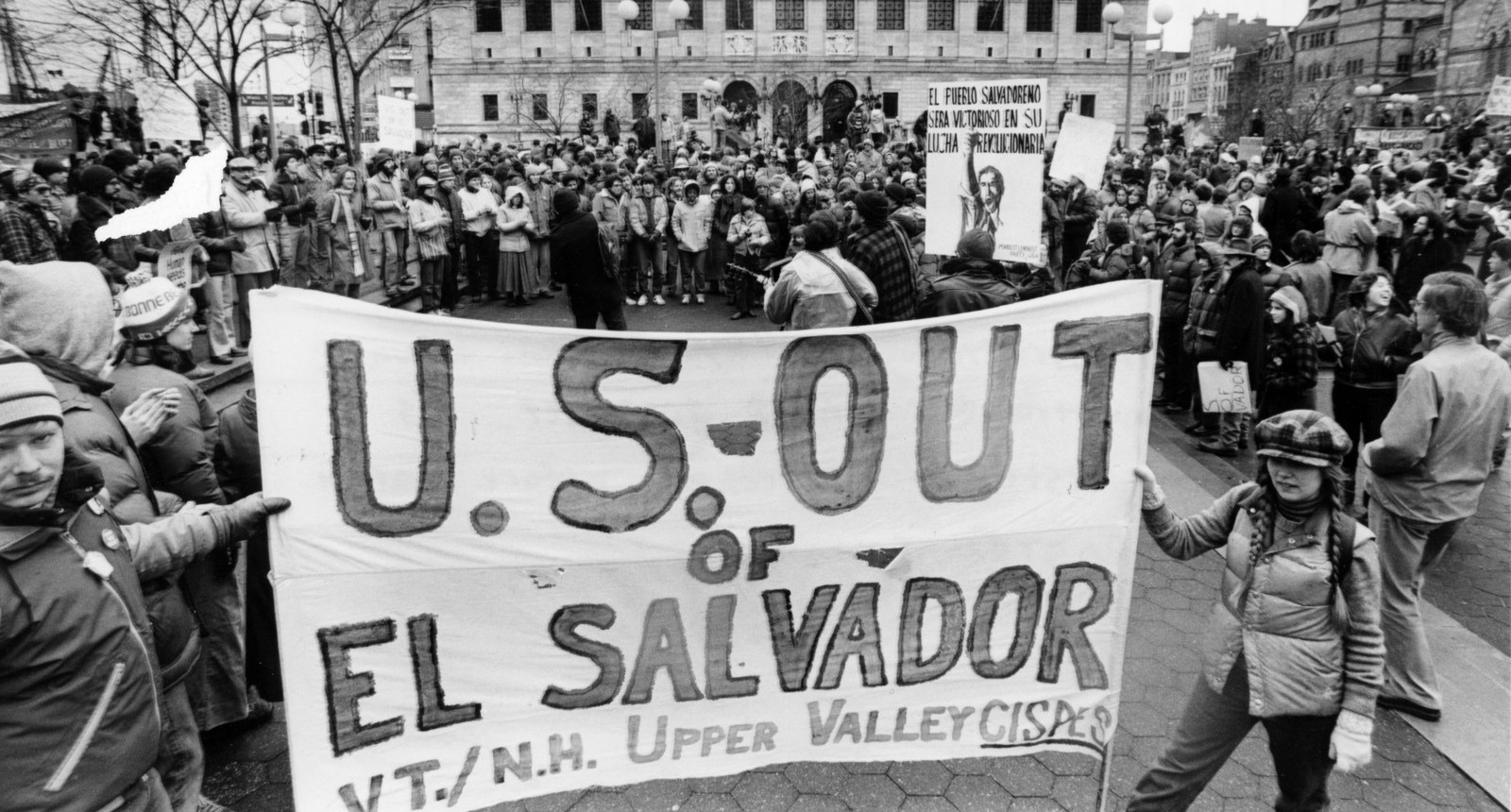
Protest in Boston against U.S. military involvement in El Salvador,
March 21, 1981.
1984: Despite
the raging civil war funded by the Reagan
administration, a mere three per cent of Salvadoran and Guatemalan
asylum cases in the U.S. are approved, as Reagan officials deny
allegations of human rights violations in El Salvador and
Guatemala and designate asylum seekers as "economic migrants." A
religious sanctuary movement in the United States defies the
government by publicly sponsoring and sheltering asylum seekers.
Meanwhile, the U.S. funnels $1.4 million to its favoured political
parties in El Salvador's 1984 election.
1990: Congress
passes legislation designating
Salvadorans for
Temporary Protected Status (TPS). In 2018, President Trump would
end TPS status for the 200,000 Salvadorans living in the United
States.
2006: El
Salvador enters CAFTA-DR, a neo-liberal
export-economy model that gives global multinationals increased
influence over domestic trade and regulatory protections.
Thousands of unionists, farmers, and informal economy workers
protest the free trade deal's implementation.
2014: The U.S.
threatens to withhold almost $300
million
worth of Millennium Challenge Corporation (MCC) development aid
unless El Salvador ends any preferences for locally sourced corn
and bean seeds under its Family Agriculture Plan.
2015: Under
the tariff reduction model of CAFTA-DR, all
U.S.
industrial and commercial goods enter El Salvador duty free,
creating impossible conditions for domestic industry to compete.
As of 2016, the country had a negative trade balance of $4.18
billion.
Honduras
1911: American
entrepreneur Samuel Zemurray partners
with the
deposed Honduran President Manuel Bonilla and U.S. General Lee
Christmas to launch a coup against President Miguel Dávila.
After
seizing several northern Honduran ports, Bonilla wins the
Honduran 1911 presidential election.
1912: Bonilla
rewards his corporate U.S. backers with
concessions that grant natural resources and tax incentives to
U.S. companies, including Vaccaro Bros. and Co. (now Dole Food
Company) and United Fruit Company (now Chiquita Brands
International). By 1914, U.S. banana interests would come to own
one million acres of the nation's best land -- an ownership
frequently insured through the deployment of U.S. military
forces.
1975: The
United Fruit Company (rebranded as the United
Brands Company) pays $1.25 million to a Honduran official, and is
accused of bribing the government to support a reduction in
banana export taxes.
|
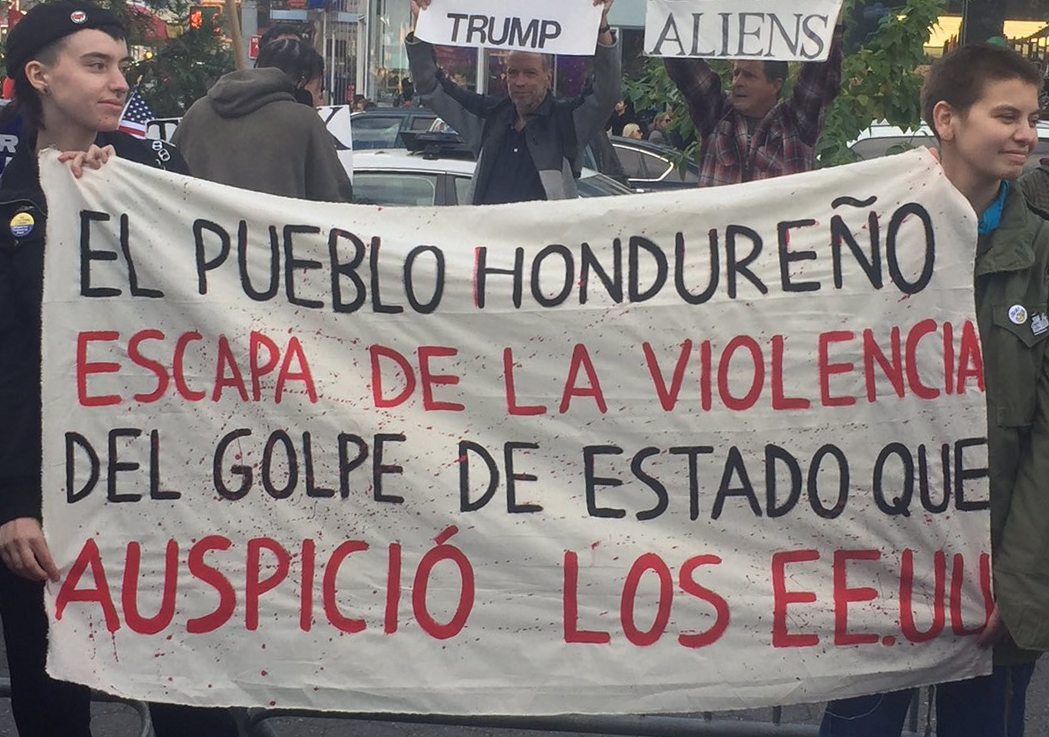
Solidarity action in New York City, November 3, 2018. Banner reads:
"Honduran people are escaping the violence of the coup d'état
carried out under the auspices of the U.S."
|
1980s: In an
attempt to curtail the influence of
left-wing
movements in Central America, the Reagan administration stations
thousands of troops in Honduras to train Contra right-wing rebels
in their guerrilla war against Nicaragua's Sandinistas. U.S.
military aid reaches $77.5 million in 1984. Meanwhile, trade
liberalization policies open Honduras to the interests of global
capital and disrupt traditional forms of agriculture.
2005: Honduras
becomes the second country to enter
CAFTA-DR,
the free trade agreement with the U.S., leading to protests from
unions and local farmers who fear being out-competed by
large-scale U.S. producers. Rapidly, Honduras goes from being a
net agricultural exporter to a net importer, leading to loss of
jobs for small-scale farmers and increased rural migration.
2009:
Democratically elected President
Manuel Zelaya, who pursued progressive policies such as raising
the minimum wage and subsidizing public transportation, is exiled
in a military coup. The coup is staged after Zelaya announces
intentions to hold a referendum on the replacement of the 1982
constitution, which had been written during the end of the reign
of U.S.-backed military dictator Policarpo Paz García. Honduran
General Romeo Vásquez Velásquez, a graduate of the U.S.
Army
training program known as the School of the Americas (nicknamed
"School of Assassins"), leads the coup. The United States, under
Hillary Clinton's Department of State, refuses to join
international calls for the "immediate and unconditional return"
of Zelaya. [The U.S. backed the coup
and, joined by Canada, has since ensured that the government it put
into power remains in power through electoral coups. -- TML Ed.
Note]
2017: Honduras
enters an electoral crisis as thousands
of
protesters contest the results of the recent presidential
election, which many allege was rigged by the ruling party.
Guatemala
1920:
President Manuel Estrada Cabrera, an ally to U.S.
corporate interests who had granted several concessions to the
United Fruit Company, is overthrown in a coup. The United States
sends an armed force to ensure the new president remains amenable
to U.S. corporate interests.
1947:
President Juan José Arévalo's
self-proclaimed
"worker's government" enacts labour codes that give Guatemalan
workers the right to unionize and demand pay raises for the first
time. The United Fruit Company, as the largest employer and
landowner in the country, lobbies the U.S. government for
intervention.
1952:
Newly-elected President Jacobo Árbenz
issues the
Agrarian Reform Law, which redistributes land to 500,000 landless
-- and largely Indigenous -- peasants.

U.S. coup d'état against the government of Jacobo Árbenz
in 1954, as depicted by
renowned Mexican muralist Diego Rivera.
1954: Fearing
the Guatemalan government's steps toward
agrarian reform and under the influence of United Fruit,
President Eisenhower authorizes the CIA to overthrow
democratically elected President Árbenz, ending an
unprecedented ten years of democratic rule in the country,
colloquially known as the "ten years of spring." In Árbenz's
place, the U.S. installs Carlos Castillo Armas, whose
authoritarian government rolls back land reforms and cracks down
on peasant and workers' movements.
1965: The CIA
issues Green Berets and other-counterinsurgency advisors to aid the
authoritarian government
in its repression of left-wing movements recruiting peasants in
the name of "struggle against the government and the landowners."
State Department counterinsurgency advisor Charles Maechling Jr.
would later describe the U.S.'s "direct complicity" in
Guatemalan war crimes, which he compared to the "methods of
Heinrich Himmler's extermination squads."
1971: Amnesty
International finds that 7,000 civilian
dissidents have been "disappeared" under the government of
U.S.-backed Carlos Arana, nicknamed "the butcher of Zacapa" for
his brutality.
1981: The
Guatemalan Army launches "Operation Ceniza"
in
response to a growing people's guerrilla movement. In the name of
"counterattacks" and "retaliations" against guerrilla activities,
entire villages are bombed and looted, and their residents
executed, using high-grade military equipment received from the
United States. The Reagan administration approves a $2 billion
covert CIA program in Guatemala on top of the shipment of $19.5
million worth of military helicopters and $3.2 million worth of
military jeeps and trucks to the Guatemalan army. By the
mid-1980s, 150,000 civilians are killed in the war, with 250,000
refugees fleeing to Mexico. Military leaders and government
officials would later be tried for the genocide of the Maya
victims of military massacres.
1982: A second
U.S.-backed military coup installs
Efraín Ríos
Montt as president. Montt is convicted of genocide in 2013 for
trying to exterminate the Indigenous Maya Ixil.
2006: Ten
years after a UN-brokered peace deal and
the
resumption of democratic elections, Guatemala enters the CAFTA-DR
free trade deal with the United States. Ninety-five per cent of
U.S. agricultural exports enter Guatemala duty free.
All articles in this
supplement were reproduced from Voice of Revolution, usmlo.org,
November 16, 2018.

PREVIOUS
ISSUES | HOME
Website: www.cpcml.ca
Email: editor@cpcml.ca
|












 The lawsuit was filed in San
Francisco federal court by
the
American Civil Liberties Union, Southern Poverty Law Center and
Center for Constitutional Rights. It seeks an injunction to
prevent the administration from implementing the asylum policy.
It charges the administration with violating the Immigration
and Nationality Act as well as the Administrative
Procedure Act.
The lawsuit was filed in San
Francisco federal court by
the
American Civil Liberties Union, Southern Poverty Law Center and
Center for Constitutional Rights. It seeks an injunction to
prevent the administration from implementing the asylum policy.
It charges the administration with violating the Immigration
and Nationality Act as well as the Administrative
Procedure Act.  The report, "'You Don't Have Any Rights Here:' Illegal
Pushbacks, Arbitrary Detention and Ill-treatment of
Asylum-seekers in the United States" reveals the brutal toll of
the Trump administration's efforts to undermine and dismantle the
U.S. asylum system in gross violation of U.S. and international
law. The cruel policies and practices documented include: mass
illegal pushbacks of asylum-seekers at the U.S.-Mexico border;
thousands of illegal family separations; and increasingly
arbitrary and indefinite detentions of asylum-seekers, frequently
without parole.
The report, "'You Don't Have Any Rights Here:' Illegal
Pushbacks, Arbitrary Detention and Ill-treatment of
Asylum-seekers in the United States" reveals the brutal toll of
the Trump administration's efforts to undermine and dismantle the
U.S. asylum system in gross violation of U.S. and international
law. The cruel policies and practices documented include: mass
illegal pushbacks of asylum-seekers at the U.S.-Mexico border;
thousands of illegal family separations; and increasingly
arbitrary and indefinite detentions of asylum-seekers, frequently
without parole. The extreme suffering that U.S. authorities
purposefully
inflicted by separating families constituted ill-treatment and in
some cases torture. Amnesty International interviewed 15 parents
and guardians separated from their children by U.S. border and
immigration authorities, including 13 who presented themselves at
official border crossings. Those family separations resulted in
extreme anguish, and in some instances long-term trauma, for
adults and children alike.
The extreme suffering that U.S. authorities
purposefully
inflicted by separating families constituted ill-treatment and in
some cases torture. Amnesty International interviewed 15 parents
and guardians separated from their children by U.S. border and
immigration authorities, including 13 who presented themselves at
official border crossings. Those family separations resulted in
extreme anguish, and in some instances long-term trauma, for
adults and children alike.


